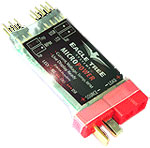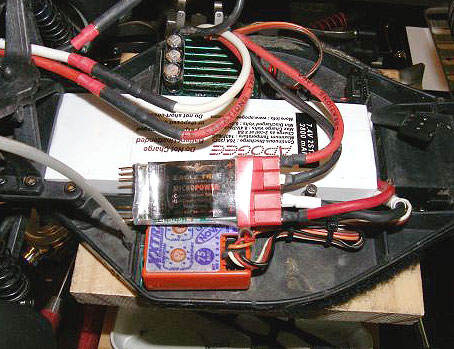|
 THE RUN DOWN : This is a device that you plug inline between your ESC and battery. As you run your car it logs the amp draw and pack voltage. It's a fantastic (and relatively inexpensive!) tool for getting the most out of your brushless systems, and diagnosing problems.
THE RUN DOWN : This is a device that you plug inline between your ESC and battery. As you run your car it logs the amp draw and pack voltage. It's a fantastic (and relatively inexpensive!) tool for getting the most out of your brushless systems, and diagnosing problems.
INSTALLATION:
First I installed the software on my laptop. The install is easy and
quick. You can then hook up the sensor to the computer, it's USB based
so it's painless. The firmware for the sensor is software upgradable,
so if there are  any updates, you'll get updated. You can also set a few recording settings up too at this time. I have mine set to take a reading 10 times a second, and to stop recording when the buffer is full. Even at that rate, it will log 20 minutes worth of data. The sensor is really small, so it's easy to fit even in a 1/18th scale r/c Installation is simple, especially if you already are set up with dean's connectors. (you ARE set up with Dean's, right?) As you can see from the pictures, you plug your battery in one side, and your ESC on the other. That's it! Once you hit the trigger it will start recording. any updates, you'll get updated. You can also set a few recording settings up too at this time. I have mine set to take a reading 10 times a second, and to stop recording when the buffer is full. Even at that rate, it will log 20 minutes worth of data. The sensor is really small, so it's easy to fit even in a 1/18th scale r/c Installation is simple, especially if you already are set up with dean's connectors. (you ARE set up with Dean's, right?) As you can see from the pictures, you plug your battery in one side, and your ESC on the other. That's it! Once you hit the trigger it will start recording.
BURNING RUBBER:
Ok, so you hook it up, go for a run, then come back and plug it in your
computer. You can get a real time playback of what happened, but the
real value is in the graphing system that's built in. You can display
you data in a number of different ways, volts, amps, watts, etc. You
can also export it out to Excel if you want, and save the graphs as
jpgs, which i'm attaching in this review. Two things that I don't have
but am getting soon is a motor RPM sensor and a temp sensor. (these
are an additional cost) All that data will be logged along with everything
else. You can also enter in your rollout data, and it will calculate
your ground speed.

GRAPHED DATA FROM THE TEST RUNS:
 Sensor =
it's the sensor (duh!) Sensor =
it's the sensor (duh!)
 Graph
# 1 = a graph of my 8000Kv RC18T running on a 2S 1500 mAh LiPo. It shows a max draw of 13A and the pack only dips 0.78v. Not bad at all. I've always liked my Hyperion packs, and now I know why. Graph
# 1 = a graph of my 8000Kv RC18T running on a 2S 1500 mAh LiPo. It shows a max draw of 13A and the pack only dips 0.78v. Not bad at all. I've always liked my Hyperion packs, and now I know why.
 Graph
# 2 = My RC10B4 running a 7700kv mamba with a converted radio shack GP3300
6 cell pack. Max draw, 76A, voltage dip 2.93v. This is why it's easy to cog
a high KV motor. The packs I have are good, but the 7700 motor really wants
a LOT of current to start. Once it gets up to speed, the voltage drop is only
about a volt and the draw is around 30A. Graph
# 2 = My RC10B4 running a 7700kv mamba with a converted radio shack GP3300
6 cell pack. Max draw, 76A, voltage dip 2.93v. This is why it's easy to cog
a high KV motor. The packs I have are good, but the 7700 motor really wants
a LOT of current to start. Once it gets up to speed, the voltage drop is only
about a volt and the draw is around 30A.
 Graph
# 3 = The same setup as above, but with an Apogee 2S 3800 mAh LiMn pack. Max
draw 106.9A (!) and the voltage only dropped 1.23v (that rates another !) You can definitely feel the difference in power with this pack. Very punchy off the line, and the graphs show why. The pack recovers from the initial launch within two tenths of a second, even when under load. At that point the voltage drop is less than a volt. Really quite impressive. Graph
# 3 = The same setup as above, but with an Apogee 2S 3800 mAh LiMn pack. Max
draw 106.9A (!) and the voltage only dropped 1.23v (that rates another !) You can definitely feel the difference in power with this pack. Very punchy off the line, and the graphs show why. The pack recovers from the initial launch within two tenths of a second, even when under load. At that point the voltage drop is less than a volt. Really quite impressive.
 Graph
# 4 = The 3800 in my friends T4 with a 5700kv mamba. You can see the amp draw
is much lower, at 85.78A. The voltage drop, even though it looks huge on the
graph is only 1.11v. We're not running the same gearing so the results are
directly comparable, but you can see the 5700 sucks a lot less juice than the
7700 Graph
# 4 = The 3800 in my friends T4 with a 5700kv mamba. You can see the amp draw
is much lower, at 85.78A. The voltage drop, even though it looks huge on the
graph is only 1.11v. We're not running the same gearing so the results are
directly comparable, but you can see the 5700 sucks a lot less juice than the
7700
 Graph
# 5 = An Apogee 3S 2500mAh pack with a 5700kv mamba. You can see from looking
at the graph that I really need a bigger 3S pack. Max draw is 69.2A, and voltage
drop is 2.41v, kinda a lot for a lipo. The pack is rated at 50A continuous,
so it's getting pushed a bit harder than it should. However, we did get 47
mph out of this setup (verified by GPS!) Graph
# 5 = An Apogee 3S 2500mAh pack with a 5700kv mamba. You can see from looking
at the graph that I really need a bigger 3S pack. Max draw is 69.2A, and voltage
drop is 2.41v, kinda a lot for a lipo. The pack is rated at 50A continuous,
so it's getting pushed a bit harder than it should. However, we did get 47
mph out of this setup (verified by GPS!)
......now for the ugly!
 Graph
# 6 = My hyper 7 conversion with 12 cells GP3300, and a feigao 10L motor.
I was wondering what was causing the cogging, now I know why. Max draw is 71.19A,
voltage drop is an astounding 9.51v! The minimum voltage is 5.6v which is definitely
why it's cogging. Those batteries just aren't up to the task. I need to try
and run this again with a fresh charge on the packs to verify this, but this
tells me that I should get a set of lipos for this beast. Graph
# 6 = My hyper 7 conversion with 12 cells GP3300, and a feigao 10L motor.
I was wondering what was causing the cogging, now I know why. Max draw is 71.19A,
voltage drop is an astounding 9.51v! The minimum voltage is 5.6v which is definitely
why it's cogging. Those batteries just aren't up to the task. I need to try
and run this again with a fresh charge on the packs to verify this, but this
tells me that I should get a set of lipos for this beast.
SUMMARY: All this for $63. Pretty sweet!
Pros:
- Great value for money
- Graphing and data software is really well done
- Firmware is user upgradeable
- Small size fits just about anywhere
- Expandable functions with additional sensors
Cons:
- Heat shrink tubing really isn't much of a "package"
- Exposed pins get bent easily
- If the pins contact a power source the device can be permanently
damaged
(there is no provision supplied to protect them)
NOTE FROM THE EDITOR: Review
written by "Sleebus.Jones", long time BYT Forum Moderator and BYT
Web Site Contributor. Sleebus is based in Texas and is an excellent source
of RC knowledge, especially in the world of electronics. We are glad to have him as a part of the BYT Team.
Thanks for the great write-up Sleebus!
|

 Sensor =
it's the sensor (duh!)
Sensor =
it's the sensor (duh!)
 any updates, you'll get updated. You can also set a few recording settings up too at this time. I have mine set to take a reading 10 times a second, and to stop recording when the buffer is full. Even at that rate, it will log 20 minutes worth of data. The sensor is really small, so it's easy to fit even in a 1/18th scale r/c Installation is simple, especially if you already are set up with dean's connectors. (you ARE set up with Dean's, right?) As you can see from the pictures, you plug your battery in one side, and your ESC on the other. That's it! Once you hit the trigger it will start recording.
any updates, you'll get updated. You can also set a few recording settings up too at this time. I have mine set to take a reading 10 times a second, and to stop recording when the buffer is full. Even at that rate, it will log 20 minutes worth of data. The sensor is really small, so it's easy to fit even in a 1/18th scale r/c Installation is simple, especially if you already are set up with dean's connectors. (you ARE set up with Dean's, right?) As you can see from the pictures, you plug your battery in one side, and your ESC on the other. That's it! Once you hit the trigger it will start recording.